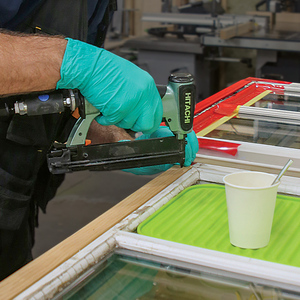Underneath our interior flatwork we typically top it off with sand over visqueen. However, the latest recommendations from Building Science experts advise placing concrete directly over the waterproof membrane to keep any infiltrating water from spreading throughout a sand layer under the entire slab. I’ve tried this technique before and have found the excessive bleed water to compromise the finishing process. I have also heard a nightmare story from another builder who experienced a “flash set” and major spider cracking when placing mud directly over plastic.
Maybe these were fluke occurences, but enough to make me wary. Does anyone have extensive experience placing concrete directly over a waterproof membrane? How has it worked? Do you adjust your finishing procedures?
Thank you for your feedback.



















Replies
I guess you just get used to pouring on poly. We NEVER put sand over the poly, mostly because we also insulate with 2" of foam. I'm wondering how wet you pour. We usually use a 5" slump, and typically we don't have a lot of bleed water. I don't think it creates any problems as long as you don't try to work it while the water is present. You just have to be patient and wait for the water to evaporate. It's going to take a little longer.
i believe the way you were doing it made for a much weaker finished product...
all you did is give the water in the mix somewhere to go fast.... which is not what you want...
the longer you hold the moisture in the mix the stronger it will be.... you can not "work the moisture out" the bleed comes to the surface after you screed... once that bleed water is gone then you can start on your surface finish... if you start before the bleed is gone then yes you will have a very weak surface on your finished product...
can't force it... when it's time to place the finish then it's time...
p
you are doing a lot of bad habits from what I read in your paragraph that is hurting the quality of the concrete. The vapor barrier always goes against the concrete to keep the subs surface material from drying out the bottom half of the mix. When the bottom dries quicker that the top, it will crack. You claim you added sand to the bottom which is wicking the bleed water. They is no need for bleed water. If you have bleed water you have exceeded the water cement ratio resulting in a weaker mix, which will crack. You are placing at a way to high slump.These habits are also effect the structural aspect of the building envelope itself.You need to be placing concrete on the vapor barrier at no more than a five inch slump, as soon as you can walk on it cut the control joints 1 1/2 inches deep. then wet the slab and cover with bisqueen for seven days, over lapping the joints with no air getting to slab at all. If you have any bleed water you are placing too wet and need to dry up the slabs. also remember a crack will developed between the wet loads and dry load, so you need to stay uniform through the whole placement
That's the most anyone has gotten outta Brownie since the hurricane. I suggest you print it out and paste it on the heads of all of your ceement workers.
Anyone argues, they get a pass to go home.
Amen.....
We're generally pouring interior slabs over 2" XPS. My strategies (which have worked) are:
(1) low water mix with water reducer added... batch for a 3" slump, add reducer to give you a 6" working slump.
(2) keep the top of the slab damp for as long as possible. Last slab I framed on I kept a hose handy and wet the slab several times a day.
If you are the GC you need to be in control of the mix. Finishers may want to order it wet to make placement easy. The water reducer takes care of that. Finishers will not stay around to mist the slab afterwards, that is your job.
If you are the GC you need to be in control of the mix. Finishers may want to order it wet to make placement easy. did it what I been preaching for years, the skyscaping falls in because of bad concrete, bad concrete because a eight grade drop out is controlling the water because his brother in law drives the concrete truck.there is only two ways to screw up concrete, 1) concrete driver 2)concrete finisher, keep them away from the water it be OK.:)
The ideal situation is when your concrete man is deeply in hock to the batch plant and cannot order anymore mix. Then you have to / get to do it. I like to order it, receive the mix ticket when they arrive, see it come out of the chute, keep the water hose away from the pour, etc. Easy to do for a small contractor.
Where are you, and what mix(es) are you using.
6mil poly over sand is almost the rule all over Texas, even in Houston, where you can be only a few dozen feet above msl.
Shoot, it's poly over cartonforms, too. Now, pour more than a hundred yards, or after sunup, and you are going to need ice in some of the truckloads, and the finishers may still be working at 2230.
that is why we ususally start the pours at 2am
I'm in Santa Cruz, CA and we generally use a six sack mix. What is msl? and cartonforms?As Marson stated previously, I guess you just get used to a certain way of prepping and finishing. And yes, we shoot for a 4-5 inch slump, 5 inch slump being more realistic. The few times we have placed mud directly on poly, with the water having no place to go but up, it seemed to us like we were dealing with an excessive amount of bleed water.Around here we generally place 1"-2" of sand over 10 mil (with 4"-6" of gravel and a topping of sand underneath). I believe the idea being the little bit of sand under the slab allows it to lose water more evenly top and bottom while still retaining the water in the sand for a slow cure underneath. We also cover the top with plastic once we are finished.Sounds like Marson and Davidmeiland also would be giving the bottom of the slab a little moisture relief with the 2" layer of insulation over the poly (if I understood that right?). However, you're placing directly over plastic and you seem to have no problems. Again, it's what one gets used to. Thanks for the feedback.Sorry, a little long winded, but if I could throw out one more question. We've started substituting flyash for cement, anywhere from 15%-25%. It's a "greener" material and is supposed to be just as strong. It acts as a very slight retarder, otherwise it seems to finish just as well. Anyone else using flyash? Noticed any differences in the finishing process or the final product?
What is msl? and cartonforms?
MSL is Mean Sea Level.
Cartonforms are handy waxed carboard box forms handy for bulking up excavated areas under flatwork next to building structure, where conventional fill would be hard to place, or expensive to buy, or both. More used in commercial work, where you have big-honking beams and piers supporting entrance structures, so they are dug out for that, but there only walkway surfaces to support in between.
I'll bet bb will back me up, flyash is good stuff. Good for strength, too--but I cringe every time I hear someone saying that to make up for some sort of weakness in the mix, they just going to add flyash to "fix" it.
Asked about region, as practices and climates differ. Practice in Texas is to ground-form everything--even when that's a less-good answer (something about buying 20-30 yards of extra fill, just to make enough "pad" to ballance a backhoe on to cut foundation beams in). Sand subgrade often just used to "even out" the rough spots between the beam trenches. Is what it is. That, and I have to go look up the conversion from sack ratio to PSI, since almost all concrete here is spec-ed to PSI strengths.Occupational hazard of my occupation not being around (sorry Bubba)